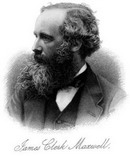James Clerk Maxwell
 James Clerk Maxwell was born on November 13, 1831 in Glenleyr (Scotland), the family lawyer. Secondary education in the Academy in Edinburgh.
James Clerk Maxwell was born on November 13, 1831 in Glenleyr (Scotland), the family lawyer. Secondary education in the Academy in Edinburgh.
Already at the age of fifteen, he presented the Edinburgh Royal Society his first scientific paper "On the mechanical plotting ovals."
In 1847 he began to study mathematics and physics at the University of Edinburgh, and then completed his education obtaining the title of Bachelor in Cambridge. Since 1856, Maxwell began teaching physics at the University of Aberdeen, and soon became a professor of physics at King's College in London.
In the same year he published his first scientific work on electromagnetic phenomena, but in the course of his activities in Aberdeen interrupted these studies. It was published a few more of his articles from the field of physiological optics, for which the Royal Society awarded him in 1860 Rumford medal. He was also involved in the study of Saturn's rings, and received the award named after English astronomer Adams.
Great merit of Maxwell in the kinetic theory of gases developing. He opened a statistical regularity in the theory of gases, and the more recent work of other scientists have confirmed its universality. The result of studies on the kinetic theory of gases was the work "Theory of Heat", which was published in 1877
In 1865, after a serious illness, he went to rest in his family estate in Scotland, where the wholly devoted himself to scientific work. Here he began to write his famous work "A Treatise on Electricity and Magnetism".
Already in previous work, Maxwell introduced the concept of displacement current in the dielectric and made sketches of the mechanical model of the electric field. In "Dynamic theory of electromagnetic field," he gave a full detailed mathematical formulation of the theory of electromagnetic field, which proved the existence of electromagnetic waves. The most important advantage of this work was mathematically developed the electromagnetic theory of the nature of light.
Maxwell showed that the oscillations of the electromagnetic waves are transverse, and derived a formula the velocity of propagation of electromagnetic waves. Comparing the speed of these waves is the speed of light, he concluded that "the coincidence of the results indicates, apparently, the fact that light and electromagnetism are a manifestation of the properties of the same substance, and that light is an electromagnetic excitation propagating in accordance with the laws electromagnetism. "
In 1871, Maxwell accepted the invitation to take the place of professor of experimental physics at Cambridge University. Great Maxwell merit in the organization of the world-renowned physical Cavendish Laboratory, where he became the first chief. In 1873 came the two volumes of "A Treatise on Electricity and Magnetism", which was summarized all that was known to him and that he has made in the field of electromagnetic phenomena.
But its main merit is that in physics it has taken the idea of the same nature of light and electromagnetic waves. And although his idea of the electromagnetic field as a "dynamic light air" was later insolvent, it had some importance for a more rapid development and the solution of theoretical problems in physics.
After 1873 Maxwell's health began to deteriorate. He died on November 5, 1879 in Cambridge.


Comments
Commenting, keep in mind that the content and the tone of your messages can hurt the feelings of real people, show respect and tolerance to his interlocutors, even if you do not share their opinion, your behavior in terms of freedom of speech and anonymity offered by the Internet, is changing not only virtual, but real world. All comments are hidden from the index, spam control.